by Alessia Leibert
January 2014
This article offers an overview of successful results for post-secondary programs in registered nursing in Minnesota and evaluates the impact of industry and geographic mobility on such outcomes.1 Finally, the study investigates hiring difficulties in nursing to assess whether workforce mobility patterns align with the needs of local Health Care employers.
Why is mobility of nurses important? Registered nurses are a high demand occupation in all regions of the state. Geographic and industry mobility of recent graduates affect the long-term supply of RNs in each local market, which then affect employers' hiring decisions. It is important to prevent local shortages of nurses before they impact the ability of Health Care employers to deliver high quality care to local residents.
The analysis of wage data for two graduation cohorts (classes of 2010 and 2011) shows registered nursing as one of the programs with the strongest workforce outcomes in Minnesota. Program success is captured by the following four indicators:
The first success measure is presented in Table 1.
| Table 1 | ||
|---|---|---|
| Employment Outcomes One Year after Completing a Program in Registered Nursing, Nursing Administration, or Nursing Research and Clinical Nursing (CIP 5138) | ||
| - | Class of 2010 | Class of 2011 |
| Total Graduates | 2,800 | 2,995 |
| Associate's | 1,742 | 1,792 |
| Bachelor's | 1,058 | 1,203 |
| Percent Employed in Minnesota (according to payroll records) | 78% | 81% |
| Unknown Employment Status (unemployed, moved out of state, became self-employed) | 22% | 19% |
| Sources: Quarterly Census of Employment and Wages (QCEW); MN Unemployment Insurance (UI) wage records; Minnesota Office of Higher Education (OHE) post-secondary graduation records. Data on each individual completing a degree from July 2010 through June 2012 were linked with wage records from all employers subject to Unemployment Insurance taxes in Minnesota.
*Graduates without reported earnings in Minnesota UI wage records could be unemployed, self-employed, or employed in another state. |
||
The portion of degree completers who found jobs in the state of Minnesota one year after graduation was very high: 78 percent for the class of 2010 and 81 percent for the class of 2011. Even in the aftermath of the Great Recession nursing degree completers were highly employable.
The second and third success measures represent growth trends over time in earnings and full-time status. Results for the most numerous and representative group, Associate's degree completers, are shown in Figure 1. Employment levels were very high (80 percent) even before graduation.2 and rose above 80 percent six months after graduation, indicating strong labor force attachment.
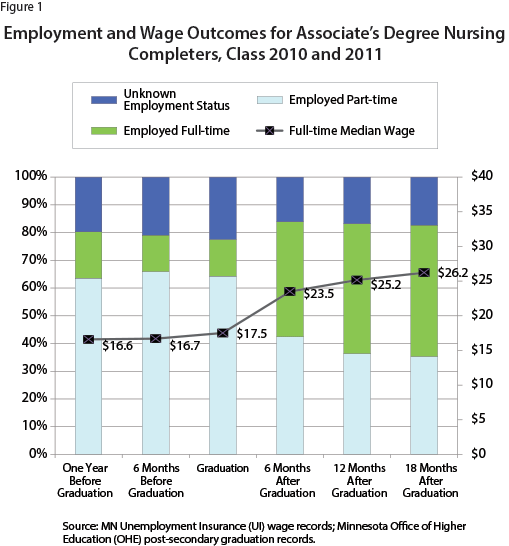
The most dramatic impacts became noticeable six months after graduation, when more new grads entered the job market. The share of full-time employment increased to 50 percent, and full-time hourly wages increased from $17.50 to $23.50. These successful outcomes are clearly attributable to degree completion and subsequent attainment of an RN license.
Finally, registered nursing programs scored high on the fourth success measure, employment in a related industry. Six months after graduation, 88 percent of employed graduates already had jobs in Health Care, the most closely related industry. High shares of employment in unrelated fields would indicate saturation in the industries that require RN skills, and this is evidently not the case.
Is Minnesota experiencing a nursing brain drain? Recall from Table 1 that 22 percent of 2010 graduates and 19 percent of 2011 graduates disappeared from Minnesota payroll records. Although some certainly left the state, the loss is too small to cause concerns.
What about mobility from one region to another within the state? The study of geographic mobility must start from a definition of who moves and who doesn't. For simplicity, we define as leaver an individual who takes a job outside of the Planning Region3. of schooling after one year post-graduation. Results show that only 13 percent of nursing graduates took jobs outside the region of schooling (Figure 2), while the majority (87 percent) landed a job either in the region in which they had been trained or in their region of residence. Such low geographic mobility implies that nursing labor markets are local in nature, and it is hard for employers to attract workers from a larger area.
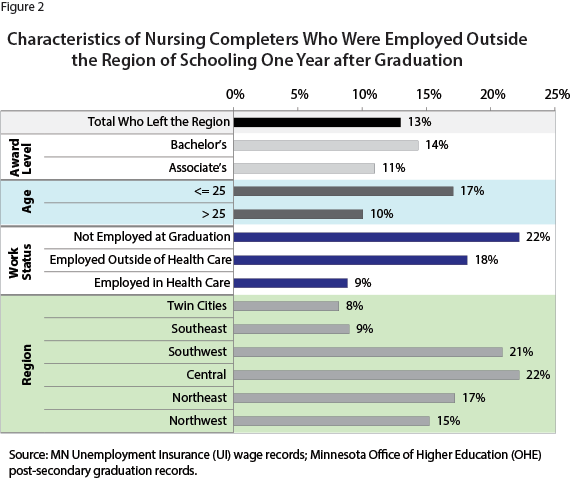
Figure 2 also presents the demographic profile of leavers to identify which characteristics might influence the decision to move. The following characteristics stand out:
Education level: As expected, Bachelor's degree completers were slightly more likely to move than Associate's degree completers. Fourteen percent of Bachelor's degree holders left the region of schooling compared to 11 percent of Associate's degree holders;
Age: Eighteen percent of individuals under 25 years of age moved versus 10 percent of those above 25. Younger graduates are more available for relocation because they are less likely to have a stable job and a family of their own;
Employment status and industry of employment: Almost one fourth (22 percent) of those who were unemployed at graduation decided to leave the region, probably in hopes of finding a job elsewhere. Those already employed in Health Care were much more reluctant to leave the region (only 9 percent did), while 18 percent of those not employed in Health Care moved. Interestingly, geographic mobility of Bachelor's degree completers was strongly driven by the desire to enter a specific industry: half of these leavers were not employed in hospitals at the time of graduation but landed a job in a hospital as a result of the relocation. This important finding shows that hospitals are drawing graduates with the highest education level out of their region of schooling;
Region of Schooling: Central and Southwest Minnesota had the highest share of leavers, 22 and 21 percent of employed individuals, respectively. The Twin Cities Metro and Southeast had the lowest shares, 8 and 9 percent respectively. Distance definitely played a role in the decision to move, as 82 percent of leavers relocated to a neighboring region.
Not only did the Metro area and Southeast Minnesota retain most of their graduates, but they benefited from a high inflow of graduates from other regions. What attracts new nursing grads to these regions? Table 2 offers some clues. First of all, employment opportunities for RNs in their industry of choice - Health Care - are highly concentrated in the Twin Cities Metro, which accounts for 55 percent of the Health Care RN workforce in Minnesota, and in the Southeast, which accounts for 17 percent. Southwest bottoms the list with only 5 percent of the state's Health Care RN workforce. Second, estimated future growth in RN employment is highest in the Metro and Southeast (26 percent) and lowest in Southwest (17 percent). Clearly, regions with lower staffing needs and lower growth are more likely to lose recently graduated nurses because of weak local demand. Third, wage differentials across regions encourage relocations especially when commuting distances are short. As expected, where demand is highest so are wages.
| Table 2 | ||||
|---|---|---|---|---|
| Region | Number of RNs Employed in Health Care in 2010 | Share of RNs Employed in Health Care over the Statewide Total1 | Projected Growth in RN Employment 2010-20202 | 2012 Hourly Median for RNs Employed in Health Care and Social Assistance |
| Twin Cities Metro | 26,554 | 55% | 26% | $35.40 |
| Southeast | 8,008 | 17% | 26% | $34.59 |
| Central | 4,135 | 9% | 27% | $35.11 |
| Northeast | 3,874 | 8% | 22% | $33.86 |
| Northwest | 3,271 | 7% | 24% | $30.97 |
| Southwest | 2,409 | 5% | 17% | $29.23 |
| Statewide Total | 48, 251 | 100% | 25% | $34.40 |
| 1Source: Occupational Employment Survey 2011 and 2012
2Source: 2010-2020 Minnesota Occupational Projections |
||||
One region, Central Minnesota, raises some concerns. Why did 22 percent of graduates leave (Figure 2) despite future demand at 27 percent and median wages at $35.11 per hour? One would expect strong local demand and competitive wages to motivate new grads to stay. Close proximity to the Metro could be a double-edged sword: on the one hand, local schools can attract students from the Metro Area and surroundings. On the other hand, graduates can easily commute to the Twin Cities where hiring in Health Care is much more frequent.
To summarize, findings suggest that relocations are motivated by the pursuit of better jobs where nursing skills are in higher demand, typically in regions where related industries are more concentrated, larger in size, or pay higher wages. Since the industry mix of a region strongly influences the decision to move, we can interpret geographic mobility as industry mobility across regions.
While geographic mobility affected only 13 percent of graduates, industry mobility affected 41 percent. Most industry transfers took place from six to 18 months from graduation and are displayed in Figure 3.
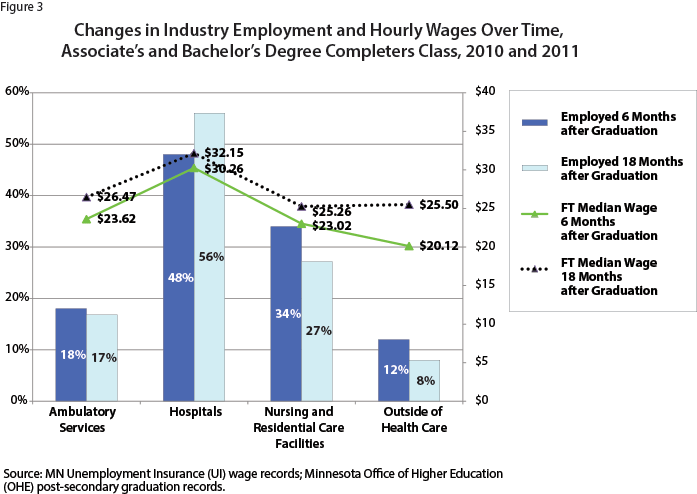
Industry of employment is important not only to determine whether skills acquired at school are properly utilized in the marketplace but because it correlates with earnings. In fact, the graph shows that new graduates can expect higher wages in Health Care - up to $30 an hour - than outside Health Care. We also notice three main outcomes of industry mobility:
These results suggest that some subsectors have more capacity to attract and aggressively recruit nurses away from other subsectors or other regions.
Are industry mobility patterns aligned with the skill needs of employers? To try to answer this question, let's look at which industries employ low-skilled versus high-skilled young graduates (age less than 255) and how wages varied by industry. The low-skilled group in our dataset is represented by Associate's degree students who are just in the process of entering the nursing profession (time of graduation), while the high-skill group is represented by registered nurses 18 months from graduation. For both education levels, the industries of employment within Health Care changed over time as experience increased, resulting in a steady increase in Hospitals and a strong decrease in Nursing Homes and Residential Care facilities. The share of Ambulatory Services remained fairly consistent over time for both education levels.

Since the shifts occurred much faster in the Bachelor's group, whose share of Hospital employment rose from 37 percent at graduation to 76 percent 18 months after, we can presume that training and work experience tends to be most rewarded in Hospitals and least in Nursing and Residential Care facilities. The declining share of Bachelor's completers in the latter does not mean that the industry laid off nurses or changed its staffing ratio toward employing more Associate's-degreed nurses.6 A more likely reason for the decline is that the Bachelor's 2010-2011 cohorts tend to exit the sector once their training and experience level cannot be adequately rewarded anymore, either with monetary incentives or better work conditions. We thus assume that vacant positions will be filled with the younger cohort of 2012 completers.
Hospitals appear to attract the highest skill level, Ambulatories the intermediate, and Nursing Homes the lowest. Although two years of data are definitely not enough to draw conclusions about long-term trends in demand for skills, we can speculate that Hospitals might need more specialized, Bachelor's-trained nurses in the future, but other sectors of Health Care might continue to rely on Associate's-degreed nurses or freshly minted Bachelor's new grads who might work there a short time and then leave.
The important implication of these findings is that job mobility in nursing responds to differences in skills demand and buying power that vary significantly by industry. So, a common career trajectory is to move to an industry that rewards the higher skills acquired on the job. Another very common trajectory is to stay with the same employer, since job tenure also can have significant advantages in Health Care.
Why are Hospitals so attractive for RNs and those with Bachelor's degrees in particular? To see if there is a wage premium in hospitals we must attempt to isolate the effect of industry from the effect of work experience on earnings. For simplicity, Figure 5 displays only students younger than 25 who do not have a long work history. The trajectory of earnings in hospitals is compared with that in non-hospital employment (Ambulatory Services and Nursing Home and Residential Care Facilities).
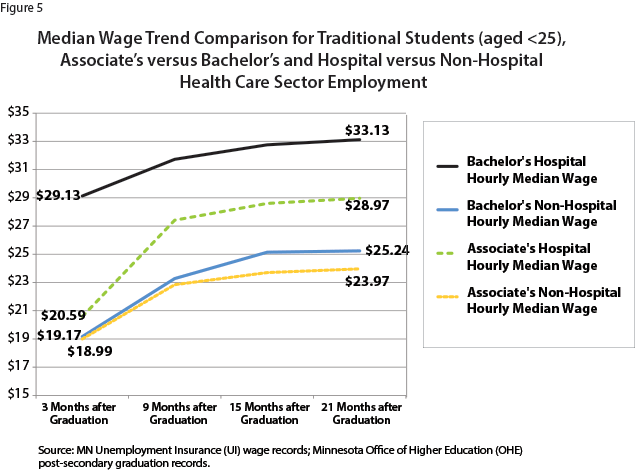
Hospitals' rates were highest for both Associate's and Bachelor's graduates. In Hospitals Bachelor's rates started very high, at $29.13, and rose gradually, while Associate's rates started lower but grew more rapidly. In other Health Care subsectors Bachelor's rates started even lower than hospitals' Associate's rates, and reached only $25.24 after 21 months from graduation. The same wage premium exists for older graduates.
The wage premium for young graduates in Hospitals might partially come from demanding work conditions or shift work, but must also be driven by something else. Higher wages for Bachelor's degreed nurses likely reflect demand for higher skills in hospitals, and higher wages for Associate's degree nurses might reflect higher anticipated hiring needs for RNs and stronger bargaining power of some hospitals. Higher-skilled nurses might be motivated to join hospitals to reap the full benefits of a four-year program. More years of data would be needed to verify these interpretations and to see if hospital nurses end up with burnout and leave the sector after a few years.
In conclusion, job mobility in Health Care appears to be driven predominantly by differences in demand for skills - ultimately from variations in skill requirements by industry-and pay differentials among industries. Efficiency exists as long as workers leave places where the market is saturated, or higher skills are under-utilized, in favor of places with unmet skill needs. But efficiency might be lost if certain Health Care sectors are hindered by continually having to replace their workforce to keep up with experienced nurses' turnover. Furthermore, the competitive disadvantage of home-based and residential care facilities raises concern at a time when policies are calling for a shift in medical care delivery toward outpatient settings and away from hospitals.
We'll now present employers' hiring experiences in nursing for the same time period, with the aim of fitting the longitudinal findings within a broader context.
The Minnesota 2012 Hiring Difficulties survey found that 28 percent of RN openings were hard to fill for employers. Factors as varied as geographic location, industry, firm size, experience level of a position, competition from other Health Care industries, and unattractive job offers (work shifts, wages, benefits) were identified as causes of the difficulties.
Consistent with the results of the cohort study, there were dramatic differences in hiring conditions among subsectors within Health Care. As shown in Figure 6, filling RN openings was hardest in Nursing and Residential Care Facilities (58 percent). Employers outside of Health Care rarely experienced difficulties, probably because nurses are not essential to their business and there is no urgency to hire.
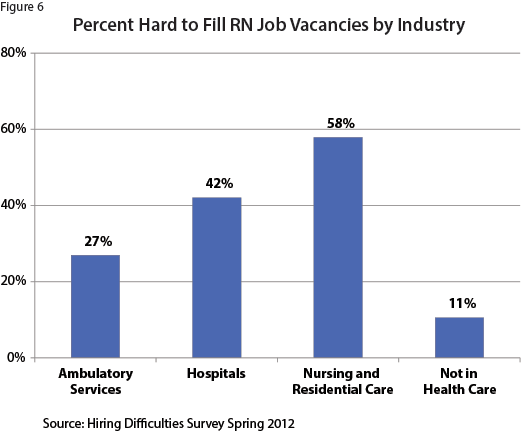
Interestingly, the desired level of skills varied by industry, with Hospitals having more trouble finding experienced or Bachelor's degreed nurses and Nursing and Residential Care facilities sectors struggling to fill associate degree, entry-level positions. Ambulatory Services' skill needs fell between these two opposites. Differences in hiring difficulties are described below.
Nursing and Residential Care facilities: Hiring difficulties were primarily caused by demand conditions, including structurally lower wages or incentives relative to other Health Care industries and to inconvenient hours or shifts. Here are some representative quotes:
"There were just not enough applicants for entry-level positions. This happens every few years: hospitals start hiring. We've lost a lot of our nurses to hospitals. It used to be that hospitals wouldn't hire new grads, but recently they have been."
"Our wages are very competitive with other nursing homes, but we can't compete with a $15,000 sign-on bonus hospitals up here are offering."
"Long-term care has a much lower wage base than the hospitals and acute care industries. We cannot increase the wage because we have lower Medicare/Medicaid reimbursements."
"This position goes into clients' homes. They need to be able to serve all clients we have in the time frame we have. It's a tough position for someone who wants to be guaranteed hours."
Hospitals: Hospitals were more likely to experience skills gaps, defined as recruiting difficulties caused by specialized requirements that make it harder to find the right person.7 Hospitals in rural or poor areas of the state were considerably more likely to encounter difficulties compared to those in urban areas.
"We can't take a brand new nursing graduate because the position operates very independently. We need at least one year of experience in an acute care setting."
"Location could be a barrier: Being a rural hospital, people do not look at us. They might prefer a city."
"We are one hour and a half north of the Metro area, in a pretty poor county, and it is hard to get people to relocate or travel this way."
Ambulatory Health Care Services: Hiring difficulties were uncommon because work conditions in ambulatories are desirable overall. When difficulties existed, they were either from uncompetitive wages, or from lacking industry-specific experience, or from undesirable work conditions in Home Health Care Services, a branch of Ambulatory Services.
"We can't raise the wage because the state and the insurance company will reimburse at a certain wage. We must pay the most of what is reimbursable but not more."
"We were looking for RNs with experience working with pacemakers in a clinic setting and could not easily find them."
"Qualified nurses would not choose home care. Normally a home care nurse needs to drive to see patients and not many nurses like to do that, especially with Minnesota's weather."
Consistent with the cohort results, hiring difficulties were lowest in the Twin Cities and Northwest (Figure 7), and high in Central Minnesota where employers complained about not being able to find experienced nurses. As we learned from the cohort analysis, this region lost locally trained nurses despite high demand and competitive wages. These conditions might signal the risk of future shortages.
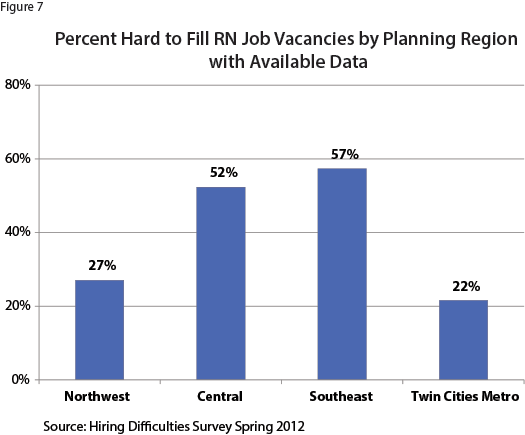
An unexpected finding was the high level of hiring difficulties in Southeast, which seems to contradict results from the cohort analysis. How can the region retain and even attract graduates from outside and yet have hiring difficulties? Employers pointed at local competition as the main problem:
"We can't compete with larger employers in terms of wages and benefits. Furthermore, another close competitor in the region is now offering a $15,000 sign-on bonus, and we can't match that."
"Our location is too close to a large hospital. We've lost some really good nurses lately down there."
"From this area people can easily commute to the Metro area or to Rochester where there are a lot of other opportunities and so a lot of competition."
Thus, difficulties can exist in certain pockets of the labor market even if the overall regional supply is adequate. Such imbalances in the allocation of local supply can pose recruiting challenges for small hospitals, rural areas of the state, or industries where wages cannot adequately reward higher educational attainment or more experience.
Blending results from the cohort study with results from the Hiring Difficulties Survey for the same time period allows us to draw the following preliminary conclusions:
More years of data are needed to verify if such hypotheses hold in the long term. Certainly this experimental study revealed that nursing labor markets - given their local nature-rely heavily on local schools to provide a steady supply of RNs. Since hiring decisions can be seriously disrupted if enrollment and graduation rates fail to keep up with demand, it is essential to monitor market trends frequently and support the efforts of local schools.
1The data in this study result from matching postsecondary education records with earnings information from Minnesota Unemployment Insurance records. By examining these data, it is possible to compare salaries of individuals before and after they obtained their degree.
2Many students were already tenured with the same employer at the time of graduation since over 70 percent were above the age of 25.
3There are six Planning Regions in Minnesota: Southeast, Southwest, Northeast, Northwest, Central, and Twin Cities Metro. Since some students have a tendency to attend school in a neighboring region, we excluded from the definition of leavers all individuals who returned to their region of residence.
4Three large employers in the Twin Cities and Southeast Minnesota accounted for 50 percent of transfers into Hospitals. The analysis has been restricted to this group to eliminate the effect of prior relevant work experience that can confound the results.
5The analysis has been restricted to this group to eliminate the effect of prior relevant work experience that can confound the results.
6The industry did not suffer from employment losses during the Great Recession and is projected to grow at a rate of 29.7 percent, so there are good reasons to believe that the overwhelming majority of these transfers were voluntary. The data do not allow us to distinguish quits from separations.
7The level of responsibility and specialization required in some hospital units - such as intensive care - might prevent these employers from hiring entry-level candidates.
This work is being funded by a grant from the U.S. Department of Labor's Employment and Training Administration to the Minnesota Department of Employment and Economic Development. More information on the Workforce Data Quality Initiative (WDQI) grants is available at the Department of Labor website.